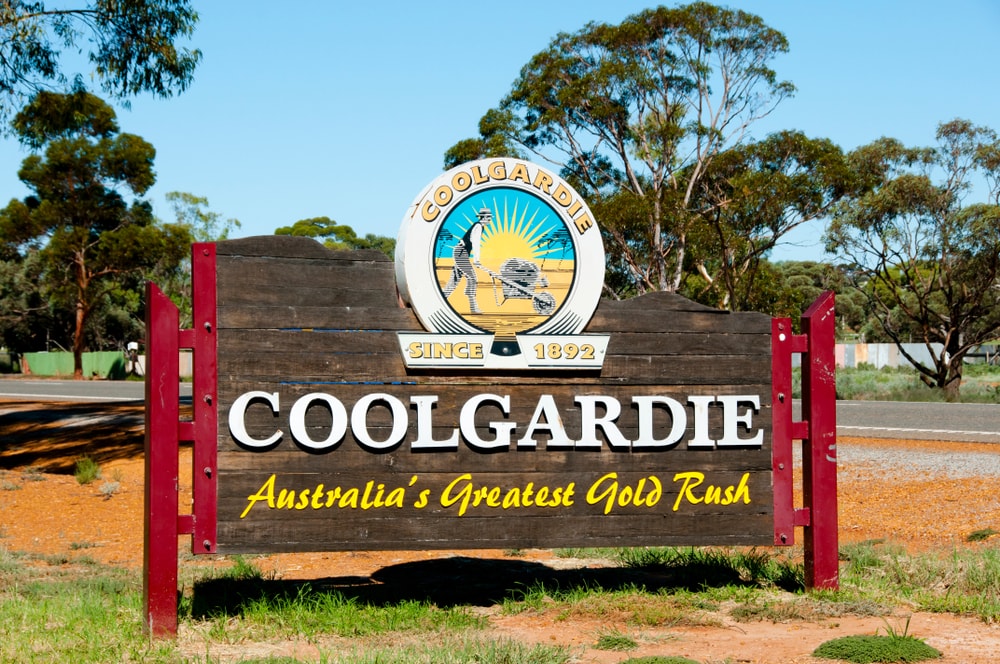
In late August 1892, at a site known as Fly Flat, prospectors Arthur Bayley and William Ford found more than 500oz of gold.
Just over two weeks later, on 17 September, Bayley registered his claim with Mining Warden – John Michael Finnerty in Southern Cross, 187km away. Worth about $800,000 at today’s values, the find triggered the last great Australian gold rush. It revived Western Australia’s struggling economy and almost quadrupled the State’s population within a decade.
Riding to inspect the find, it is said that Finnerty visited a near-by rock-hole and wrote down its Aboriginal name, Coolgardie, the name Coolgardie is said to be derived from the Aboriginal word “Coolcaby” meaning a mulga tree near a waterhole, which the goldfield town was later named. Another possibility is “Coorgardie”, the Aboriginal name for a large lizard. Over the years, Coolgardie has also been known as Bayley’s Find, Fly Flat and The Old Camp.
One thing is certain, Warden Finnerty was the person responsible for sending telegram No. 3098 to Perth which read: ‘Very rich quartz reef… Gold has been picked up on the surface four miles square in granite, ironstone and greenstone.’ and thus sparked the largest gold rush in the nation’s history.
Coolgardie was gazetted in 1893 and, by 1898, was the State’s third largest population centre with 15,000 residents and at least another 10,000 in the district. In 1899 the town celebrated its mining industry with a World Exhibition attended by more than 61,000 people.
John Michael Finnerty saved lives when water was short by persuading the government to provide tanks along the road and by ordering diggers back to Southern Cross, allowing them to resume their claims after the winter rains. Much to Finnerty’s anger the gnamma was later blasted in a futile attempt to get more water.
Finnerty helped plan the town of Coolgardie where he was warden from 1894; it rapidly became the third largest town in the colony but then the field declined. He was a fair man, in an outspoken community he used common sense to interpret the regulations of an Act which gave wide supervisory powers to wardens.
In 1895, the splendid residence was built for Coolgardie’s first Resident Magistrate and Mining Warden, Irishman Finnerty for his wife Bertha and two-year-old daughter. With the harsh climate in mind it was constructed of local stone and brick with tall windows with louvered shutters, large verandahs and a ventilated roof lantern, which in turn is responsible for keeping the place cool. The builder was the late timber magnate Robert Bunning.
The magnificent residence is preserved to this day in Coolgardie, with a few pieces of the Finnerty’s original furniture complimented by pieces from all over Australia from the same era. The chair by the fireplace in the parlour was owned by Bertha and was used as a nursing chair from where she would feed and bathe her babies.
Finnerty was transferred to Kalgoorlie in 1900, marking the decline of Coolgardie and Kalgoorlie’s rising prominence as the centre of WA’s eastern goldfields, but his house remains on ‘Montana’ Hill overlooking the town. Coolgardie’s gold production diminished in the early 1900s and by 1914 the town was in decline.
Though in 1911, Finnerty retired to a property near Geraldton where he died of diabetes with infection on 8 December 1913, survived by two daughters and a son. He was buried in the Urch Street cemetery with a gravestone erected by goldfields friends.
He had been a fellow of the Royal Geographical Society, a Freemason and president of the Coolgardie Liedertafel. With the rank of lieutenant-colonel he commanded the Goldfields Regiment of the Volunteer Defence Force. A great raconteur, he wore a full beard with a ‘walrus’ moustache and had a commanding but genial presence.
He was a big man, physically and officially, good at his job. For twenty-five years Finnerty interpreted the mining acts with discretion and his decisions were respected. As a bushman, his authority and leadership were accepted in the camps: no officer of the Crown was held in higher regard in the mining community.
By 1980, its population down to about 200, Coolgardie was almost a ghost town. Coolgardie, known as the Mother of the Goldfields in honour of its position as the first town of the Eastern Goldfields.
